

The cameras onboard the Hayabusa spacecraft are intended not primarily for scientific observation but for optical navigation. By imaging the designated asteroid, they allow the spacecraft to estimate its own speed and location in relation to the asteroid, so that the spacecraft can fly autonomously. But of course these cameras have also helped in the scientific investigation, by taking images of the asteroid Itokawa that were transmitted to Earth. Their task was not only to take photos of the asteroid's surface, but also to do detailed investigation of color variations on the surface, using the cameras' seven color filters to observe the range of brightness and colors on Itokawa. Hayabusa's cameras took approximately 1,500 images, revealing the unique shape and surface of Itokawa.
Q. What was the procedure flow from imaging to image analysis?
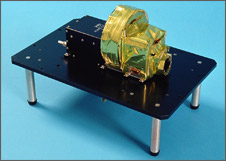
Asteroid Multiband Imaging Camera (AMICA)
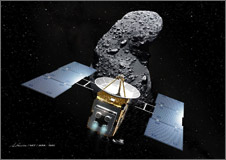
Hayabusa observing the asteroid Itokawa (artist's rendition by A. Ikeshita and JAXA/ISAS)
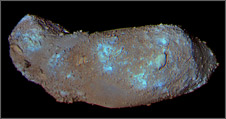
Image with color harmonization. Bluish and reddish areas are seen.
You might intuitively imagine a spacecraft taking images by traveling around its object, but Itokawa is such a small celestial body that Hayabusa took images of the asteroid as it rotated, while hovering at a fixed distance from it. Itokawa's rotation period is 12 hours, so its entire surface can be captured in that time. To get an overall view of Itokawa, the spacecraft shifted its position, both laterally and vertically, to take images from various angles.
Once the images were transmitted to Earth, about 30 experts gathered to analyze them. Teams with different specialties were formed to look at, for example, the distribution of rocks by size and numbers, images taken from various angles, and color variations on the asteroid's surface. The data acquired with Hayabusa's other observation instruments, such as the Near-Infrared Spectrometer (NIRS) and the Laser Range Finder (LRF), were also used. At the end of each day, we gathered to report the teams' progress, and exchanged ideas for the next day's agenda and future research.
Q. What can you find out by studying the differences in color and brightness on the asteroid's surface?
Itokawa was originally believed to be a piece that broke off from a larger asteroid in a collision with another celestial body. So we didn't expect to see much variation in the colors and brightness on the asteroid's surface. But to our surprise, we discovered that there are bright and dark areas on Itokawa, and that in general the bright areas are bluish and the dark areas are reddish. Dark areas are believed to be formerly bright areas that have been darkened by solar winds or impacts with micrometeorites through the asteroid's long exposure to space. This sunburn phenomenon, which is also observed on the lunar surface, is called space weathering. Meanwhile, bright areas on Itokawa are thought to be the result of rocks on the asteroid's surface having been moved somehow to expose the ground underneath, which had not incurred space weathering, and settling to form a new surface. This process is currently under investigation. It was a great surprise and very exciting to find such complicated colors and topography on Itokawa, which is merely a 500-meter asteroid.
Q. What do you remember most vividly from Hayabusa's operations thus far?
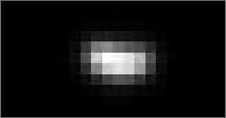
Image of Itokawa taken by Hayabusa from about 1,000 km away, on September 4, 2005
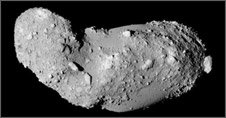
Asteroid Itokawa
It became very exciting around the end of August 2005, when Itokawa gradually came into sight. Based on ground-based observations, Itokawa had been presumed to be round, but as Hayabusa approached it, we saw that the asteroid had an irregular shape. It was an unforgettable moment for me when Itokawa, which was just a dot in the beginning, came clearly into view.
The other memorable Hayabusa operation for me was its touchdown. We, of course, wanted to obtain many photos when the spacecraft was approaching the surface, so we had spent a lot of time planning how to take as many effective photos as possible in the midst of a busy operation schedule. Of course, many unexpected incidents occurred during the approach, so we kept in touch with the operation staff and told them when and where to take an image each time. I'm very excited about the contribution these precious images will make to research.
Q. What have you learned through the Hayabusa mission?
Many people gather to achieve something major as a team, which can never be accomplished by one individual. I've learned that a project depends on people, and on their management. Our camera team consists of 30 people, and naturally we all have different personalities. Some are much more assertive than others, for example. There were times when discussions fell into such disorder that they sounded like quarrels. But even in such circumstances, instead of invoking my authority as leader and settling the disputes, I tried to step back and let the team members resolve issues on their own. I also tried to understand each staff member, and to create an environment for everyone to be able to contribute their best work. They are all professionals, so they don't need to be given instructions on how to do their job. But I've realized that the project has a greater chance of success when people are positioned in a way that they are allowed to do their best. I think that success is achieved through the teamwork of the right experts in the right places.
Q. What do you think about Hayabusa's return?
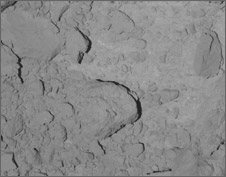
The surface of Itokawa
My background is meteorite research, so I'd like to see fragments of the asteroid, no matter how small. Research has shown that meteorites are stones that have fallen from space, and that there is a close relationship between meteorites and asteroids. But we still don't know the degree of similarity or difference between stones collected from an asteroid and meteorites that fell to Earth. It looks like the rest of the Hayabusa operation will continue to be very challenging, but I do hope that the spacecraft will come back to Earth safely, with the sample return capsule.
Q. What is your dream for the future?
There are many different types of asteroids, and I'd like to do research on samples collected from various ones. It is my dream to clarify the relationship between meteorites and asteroids. I've also been interested in human space travel since I was a child, so I think it would be wonderful if the success of the Hayabusa mission could be applied to technologies for building a base on the Moon or on an asteroid.
Q. Do you have a message for children who wish to be part of future space development?
I'd like to nurture in children a fascination with nature: mountains, rivers or stones - anything would be fine. I'd like you to get interested in nature, no matter in how small a way. And if you have that interest, the next step is action. Seek what interests you. And if you come across something you don't know, do an experiment to find out about it using the things available around you. “Doing” is very important. The feeling of excitement and taking action - I think these two ingredients are what make science fun. I'd like you all to have that, too.
Doctor of Science. Research Fellow of the School of Engineering, Tokai University.
In 1991, Dr. Saito got the doctoral degree of science at the Mineralogical Institute, University of Tokyo by the research of the mineralogy of meteorites, and moved to the National Aerospace Laboratory of Japan (NAL) as a Postdoctoral Fellow. In 1995, he moved to the Technical Research Institute, Nishimatsu Construction Co. Ltd. and joined to the MUSES-C (Hayabusa) project. In 2005∼2007, Dr. Saito was a Research Fellow of the Hayabusa Project Team of the Institute of Space and Astronautical Science (ISAS), JAXA, and currently is a Research Fellow at Tokai University. He specializes in meteorites, remote sensing, and research for the development and utilization of the Moon and other planets.







